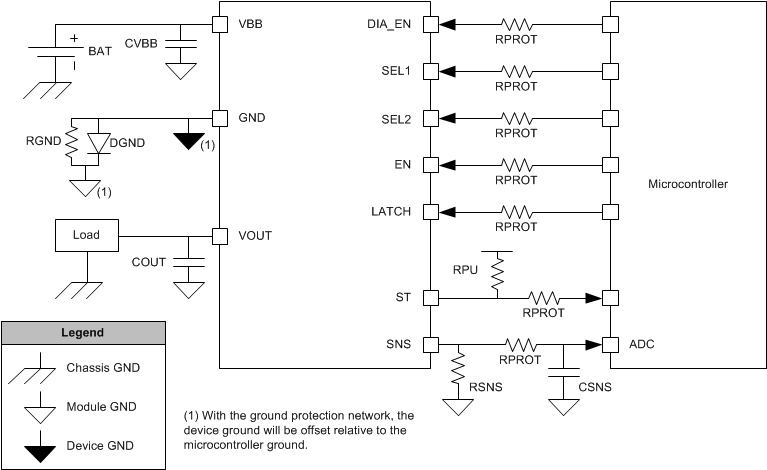SLVSDM4D November 2018 – December 2019 TPS1HA08-Q1
PRODUCTION DATA.
- 1 Features
- 2 Applications
- 3 Description
- 4 Revision History
- 5 Device Comparison Table
- 6 Pin Configuration and Functions
- 7 Specifications
- 8 Parameter Measurement Information
-
9 Detailed Description
- 9.1 Overview
- 9.2 Functional Block Diagram
- 9.3
Feature Description
- 9.3.1 Protection Mechanisms
- 9.3.2 Diagnostic Mechanisms
- 9.3.3 Enable Watchdog
- 9.4 Device Functional Modes
- 10Application and Implementation
- 11Power Supply Recommendations
- 12Layout
- 13Device and Documentation Support
- 14Mechanical, Packaging, and Orderable Information
10.1 Application Information

With the ground protection network, the device ground will be offset relative to the microcontroller ground.
Figure 54. System Diagram Table 4. Recommended External Components
| COMPONENT | TYPICAL VALUE | PURPOSE |
|---|---|---|
| RPROT | 15 kΩ | Protect microcontroller and device I/O pins |
| RSNS | 1 kΩ | Translate the sense current into sense voltage |
| RPU | 10 kΩ | Provide pull-up source for open-drain output |
| CSNS | 100 pF - 10 nF | Low-pass filter for the ADC input |
| RGND | 4.7 kΩ | Stabilize GND potential during turn-off of inductive load |
| DGND | BAS21 Diode | Protects device during reverse battery |
| CVBB | 220 nF to Device GND | Filtering of voltage transients (for example, ESD, ISO7637-2) and improved emissions |
| 100 nF to Module GND | Stabilize the input supply and filter out low frequency noise. | |
| COUT | 22 nF | Filtering of voltage transients (for example, ESD, ISO7637-2) |